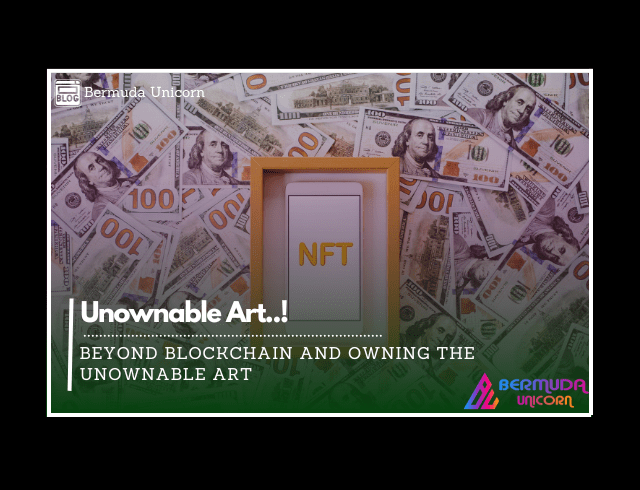![]()

Introduction
In an age of rapidly evolving technology, blockchain has emerged as a transformative force that extends far beyond its origins in cryptocurrencies like Bitcoin. It has given us a glimpse into the future of digital ownership, a world where we can truly own the Unownable Art. This blog explores the concept of blockchain and its potential to revolutionize ownership, transcending traditional boundaries and unlocking new possibilities.
The Evolution of Blockchain
Initially conceived as a decentralized ledger for cryptocurrencies, blockchain has come a long way since its inception. It is a distributed database that stores information across a network of computers. This network ensures transparency, security, and immutability of data. While the earliest use case was digital currencies, blockchain technology has grown to encompass various industries, from finance and supply chain management to healthcare and even art.
Ownership in the Digital Age
In the digital age, ownership has taken on a new meaning. It’s no longer limited to tangible assets like land, homes, or physical goods. Now, we can own digital assets, and blockchain has played a pivotal role in redefining this concept.
1. Cryptocurrencies:
The most obvious example is Bitcoin and other cryptocurrencies. They are purely digital assets that exist only in the digital realm, yet blockchain technology allows us to own and trade them securely.
2. Digital Art:
The rise of Non-Fungible Tokens (NFTs) has revolutionized the art world. Artists can now create digital art pieces and sell them as NFTs, granting buyers true ownership. Blockchain ensures the provenance and authenticity of these digital assets.

3. Digital Collectibles:
From virtual trading cards to in-game items, blockchain has extended ownership to a wide range of digital collectibles, offering a new level of scarcity and value to these assets.
4. Intellectual Property:
Musicians, writers, and content creators can use blockchain to protect their intellectual property and receive fair compensation for their work without intermediaries.
Beyond traditional assets, blockchain has created a world where anything that can be represented digitally can be owned and traded.
The Power of Decentralization
The essence of blockchain’s enchantment resides within its decentralized nature. Traditional ownership often relies on intermediaries like banks, government institutions, or corporations to verify and enforce ownership rights. In contrast, blockchain technology allows peer-to-peer transactions without the need for middlemen. This decentralization democratizes ownership and removes the potential for censorship or manipulation by centralized authorities.
Immutable Ownership Records
Once a transaction is recorded on the blockchain, it is virtually impossible to alter or erase. This ensures the permanence and immutability of ownership records.
Transparency
The transparent nature of blockchain means that anyone can verify ownership and transaction history, promoting trust and reducing the risk of fraud.
Security
Blockchain’s cryptographic security measures protect ownership rights, making it incredibly difficult for unauthorized parties to gain control over digital assets.
Challenges and Considerations
While blockchain technology offers exciting opportunities for owning the unownable, it’s not without challenges. These include:
Scalability
As blockchain adoption grows, scalability remains a hurdle to overcome, particularly in popular networks like Ethereum.
Regulatory Uncertainty
Governments are still grappling with how to regulate blockchain and digital assets, which can create uncertainty for users and investors.

Environmental Concerns
Proof-of-work blockchains like Bitcoin have faced criticism for their environmental impact. However, many blockchain projects are working on more sustainable alternatives.
Security Risks
While blockchain is known for its security, it’s not impervious to attacks, and users must remain vigilant.
Conclusion
Blockchain is changing the way we perceive ownership, transcending the physical world and bringing the concept of ownership into the digital realm. As technology continues to evolve and mature, the possibilities for owning the Unownable Art will expand further, touching industries and aspects of our lives we’ve yet to imagine.
From digital art and collectibles to intellectual property and even our personal data, blockchain technology has the potential to revolutionize the way we assert and protect ownership rights. It brings us closer to a future where we truly own our digital assets, and in doing so, we shape the art of owning the Unownable Art.
Frequently Asked Questions :
1. What is an NFT, and how does it relate to ownership in blockchain?
NFT stands for Non-Fungible Token. It represents unique digital assets (e.g., art, collectibles) on the blockchain, proving ownership and authenticity.
2. How does blockchain ensure the security and authenticity of digital ownership?
Blockchain’s decentralized, transparent, and immutable ledger secures digital ownership by making tampering difficult and allowing verification by anyone.
3. What are the environmental concerns with blockchain, and how are they addressed?
Some blockchains use a lot of energy, but solutions like eco-friendly consensus mechanisms and energy-efficient practices are being adopted to reduce environmental impact.
4. What are the legal and regulatory challenges for digital ownership via blockchain?
Regulations vary by region. It’s essential to stay informed about local laws and regulations, as governments work on clearer frameworks for blockchain assets.
